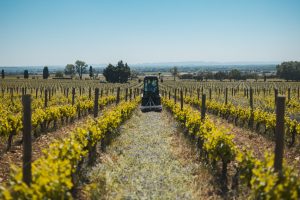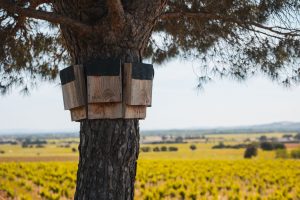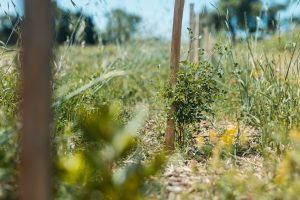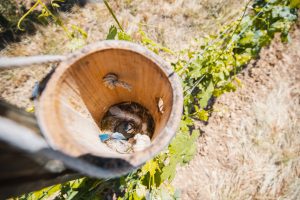
Agroecology : Committed Viticulture in Service of Nature
Wine, a gift of nature as precious as it is fragile, is increasingly faced with the consequences of climate change. Anxious to continue its centuries-old wine heritage, Château La Nerthe converted its vineyard to organic farming as early as 1998. But we did not stop there. By uniting viticulture and agroecology, we have consistently favored more sustainable farming practices to maintain a balance in the ecosystem. This strong and fundamental commitment is translated into concrete action through seven major levers.
Agroecology and Viticulture: A Matter of Balance

The French wine industry has been organizing for several years to promote an agroecological transition in the vineyards. The French Institute of Vine and Wine, in collaboration with the Ministry of Agriculture and INRA, has established seven main themes to be addressed providing a clear framework for estates that want to commit to more sustainable viticulture. Day by day, with passion and care, Château La Nerthe considers each of these in its vineyard.
Preserving the Quality of Unique Terroir Soils

In addition, Marine Albert, our Vineyard Manager, promotes the regeneration of our wine-growing soils. Specifically, she combines fertilization and plant cover to improve soil structure, biological activity, and richness, among other benefits, thus optimizing the potential of our terroirs. Legumes are introduced into our plant cover: vetch, fava beans, peas, and clover. These plant families fix atmospheric nitrogen in the soil thus enriching it.
Finally, we work to limit the risks of water erosion, (meaning soil displacement during runoff), partly thanks to these plants which slow runoff and its impact. Water penetrates the soil more effectively along their roots, while soil particles aggregate around these same roots.
Protecting and Promoting Biodiversity in the Heart of the Vineyards

To contribute to the full flourishing of life, we use plant cover, cultivate grass in the vineyard rows, practice eco-grazing with sheep on our plots during winter, and plant forest hedges and fruit trees (fig, plum, hazelnut, etc.), prioritizing local varieties.
Within the plots, the landscape dimension of biodiversity is supported by the creation of ponds or integrating nesting boxes for blue tits, bats, and owls – a way to provide shelter for protected species in Châteauneuf-du-Pape. Bees are also at the center of our attention, with several beehives. To support these precious pollinators and participate in the protection of the environment, we sow honey flowers, as in our exceptional Cassagnes vineyard in the Côtes du Rhône.
Increasing the Use of Biocontrol in the Plots

Biological control is another way we reduce the impact of certain pests. By introducing parasitoid insects onto our plots who thrive at the expense of grape enemies.
In addition to playing an essential role in protecting biodiversity, nesting boxes, hedges, and ponds scattered throughout our vineyard also have a regulatory effect as they are teeming with birds and small animals that feed on pests.
Ensuring Water Resource Preservation in the Vineyard
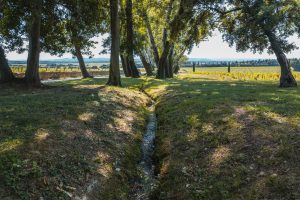
This is why Château La Nerthe is committed to adapting its vineyard to these new water constraints through several actions: proper soil preparation before planting, choosing plant material that is more tolerant to drought, thoughtfully managing the canopy to utilize the benefits of its foliage effectively, and reasoned and precise irrigation through water stress measurement.
In addition, we collect as much rainwater as possible around our plots, having built drains and water retention basins to allow heavy rains to be channeled, thus limiting erosion. Water that does not immediately penetrate the soil is stored in ponds or ditches lining the vineyard before slowly seeping into the ground.
Selecting Plant Material Suited to Agroecological Challenges

The adaptation of plant material is also a lever to address tomorrow’s challenges. The plants in our new plantations come from a mass selection, with wide genetic diversity, for more resilience against diseases and pests.
Our tree and forest hedge plantations are made from plant material taken from the natural areas surrounding our plots, ensuring successful establishment and cohabitation with the vineyard. We collaborate with a producer of wild plant materials who gathers and reproduces the most interesting plants from the surrounding areas, and we reintroduce them into our vineyard plots.
Adjusting Wine-Growing Practices to the Effects of Climate Change
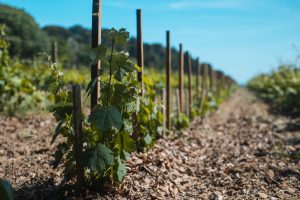
As for our choice of plant material, we prefer rootstocks that are more suitable to resist climate change and future droughts. And our plantations are composed of the region’s traditional grape varieties, which are more resilient to extreme temperatures.
Caring for Air and Atmosphere Quality

Furthermore, as part of our constant improvement efforts, we are currently studying the additional recommendations from the French Institute of Vine and Wine to protect air and atmospheric quality.
Through each of these numerous actions, viticulture and agroecology merge at the heart of Château La Nerthe’s philosophy. This sensitivity to nature contributes to a better balance of ecosystems and makes all the difference in bringing high-quality grapes to life, so we may continue crafting exceptional wines, faithful to five centuries of excellence.


